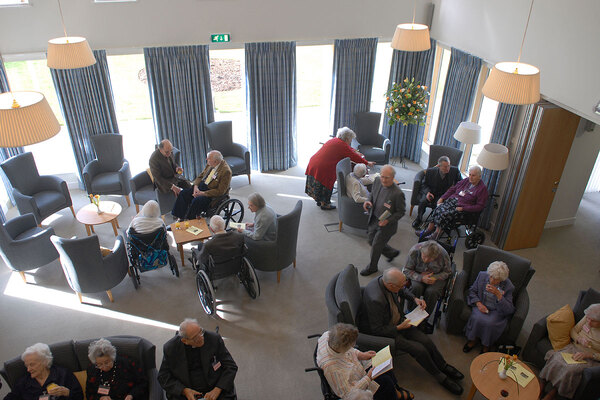The downsizing dilemma
Too few older people are downsizing, meaning families are missing out on homes with more bedrooms. Emily Twinch finds out if and how the housing sector can overcome the problem.
Video:
features style

Imagine the scenario: you have grown old, your children have moved out and you have one, two or even three extra bedrooms.
These rooms are now surplus to requirements and it makes sense to move to a smaller property, which could then free up that larger home for one of the tens of thousands of families in the UK who need a bigger house.
But it is not that simple; you have spent years in that house, and invested time and money in it. And what if you do not want to move away from an area where you have support networks of friends and family?
Barriers to overcome
Older people are not downsizing nearly as much as they could and so family homes are not being freed up where they might.
A January 2016 report from thinktank the International Longevity Centre showed that just 15.6% of homeowners aged over 55 who were considering downsizing had moved to a smaller property.
With an ageing population and a housing shortage, solutions need to be found.
So why are older people not downsizing? What are the barriers and can they be overcome?
Video:
Ad slot
Research from Family Mosaic, shared exclusively with Inside Housing, gives an insight into the problem.
“We are not building enough homes and there is just not a range of homes that older people want to move into”
Alistair Smyth, National Housing Federation
Of 700 social tenants surveyed, 160 are over 50 years old. Of those, 99 (62%) want to stay in their home and 40 (25%) want to move. Ten out of the 40 (just 6% of all those aged 50-plus) want to downsize.
Reuben Young, research and performance analyst at Family Mosaic, says there are two bottlenecks stopping many older people downsizing.
“First, a lot of people don’t want to downsize. They have an emotional connection to the property, or they have concerns about not having enough floor space.
“Second, most of them are not finding the services on offer.” It is often hard for them to find appropriate schemes because they are not online.
Right type of home
Over the past year, 37 Family Mosaic tenants have downsized - but this includes people of all ages. Mr Young says more can be done to encourage older people to move.
“A lot of people register interest and ask to be put on our transfer list,” says Mr Young. “But then there is a drop-off of people who bid for properties.” Not being able to stay in your local area is a big reason for rejecting a void, Mr Young believes.
Persuading older people, who will invariably have lifetime tenancies, to downsize is clearly problematic.

But the issue also exists in the private sector. Tony Watts, chair of the South West Forum on Ageing, says the conundrum comes down to supply of the right type of home. “The issue that a lot of people face in downsizing is that there’s not enough product out there. It’s difficult to stay locally to support networks [and] not everyone likes a flat. Often people need a place for relatives and carers to stay.”
Alistair Smyth, head of policy at the National Housing Federation (NHF), agrees: “It’s the general undersupply point. We are not building enough homes and there is just not a range of homes that [older] people want to move into.”
“There are no small properties available and a lot of one-bedroom accommodation is small flats, not suitable for older people.”
Hugh Owen, Riverside
Mario Ambrosi, head of corporate affairs at Anchor, which - among other things - builds retirement homes to sell on the open market, says the planning system makes it difficult to build homes for older people.
“Building retirement housing is expensive,” he says. “The issue is around the ability to find sites, and if you can find sites, the difficulty of getting planning permission.”
Furthermore, retirement housing often needs communal areas and it is difficult to compete with other developers that can maximise density and pay more for sites. Higher-density developments are also more likely to be able to absorb councils’ requirements for infrastructure and social homes as part of Section 106 agreements.
On the social side, providers have said they are putting supported housing schemes, including for older people, on hold because of the potential drop in funding when the Local Housing Allowance (LHA) cap comes in in 2019. An Inside Housing survey of 82 providers in January showed only 5% thought their supported housing schemes (including homes for older people) could survive the benefit cut.

Hugh Owen, director of policy and communication at Riverside, believes there are already not enough suitable properties in the social sector for older people to move into.
He is concerned about what this will mean when the LHA cap comes in for all tenants. The cap will mean that the benefit that tenants receive will depend on LHA rates in their area.
While this could encourage older people to downsize, Mr Owen is concerned the sector may see a rise in older people defaulting on rent payments and having nowhere to go.
“LHA caps are based on the size of the household, not the size of the house,” he explains. “So, for an older couple, they will only be entitled to a one-bedroom rate.
“There are no small properties available and a lot of one-bedroom accommodation is small flats, not suitable for older people.”
Riverside and the NHF are calling on the government for older people to be exempt from the LHA cap.
But should their appeal fall on deaf ears, what other solutions are being sought for the downsizing dilemma? Some councils and housing associations already offer incentives to potential downsizers, but clearly more needs to be done.
Tailor-made homes
Family Mosaic, in its report out next month, suggests offering more voids to downsizers first. If the properties are rejected, they can then go onto the council waiting list.
“Three or four times as many voids would be shown to older people through this method,” estimates Mr Young. “It would stand to reason with the increased number of homes offered, older people would find a suitable home closer to them.”
Mr Smyth says it is important not to put “pressure on [older people to move]” but create the “right conditions” to make it a desirable prospect.
“It’s about growing the downsizer market,” he continues. “It needs to be seen as an attractive offer.”
Hanover, for example, has a portfolio of affordable rent, shared ownership and outright sale homes marketed as “tailor-made” for the over-55s.
Claire Anderson, deputy to the executive director of development at the 19,000-home association, says: “Downsizing can be a liberating process, an opportunity for a better, unburdened lifestyle that brings about a sense of freedom. It doesn’t mean downgrading.” Indeed, testimonials show downsizing does work for some (see box: Downsizing success stories).
Mr Ambrosi believes the government can do more, too. He says it should focus on older people’s housing as well as the Starter Homes market, waive stamp duty for downsizers and make retirement homes exempt from the Community Infrastructure Levy. There is social value in specialist retirement housing, he says. “You are less likely to have a fall, and less likely to have health interventions and end up in the NHS [A&E].”
Whatever the range of solutions, one thing is certain: with an ageing population, the problem of a slow rate of downsizing is not one that is going away any time soon.
Downsizing success stories
London
Sixty-three-year-old Jennifer Myrie moved from her two-bedroom Family Mosaic property to a one-bedroom flat in Walthamstow this April. She asked to be downsized in 2013 because she became liable for the ‘bedroom tax’ and found she could no longer afford the extra room. “I absolutely love it,” she says of her new flat.
“It feels like home”. The flat is quieter than her old property, but her six children and grandchildren are no longer able to visit at the same time. She says it’s the “only downside”, but adds that she “can go and visit them”.
Greater Manchester
Pat and John Whitmore, aged 77 and 83 respectively, moved to an Irwell Valley sheltered housing one-bedroom flat in Sale, Greater Manchester, from a privately rented property in 2011. “We had to downsize and do a bit of editing of our possessions but it’s worked out very well,” says Mr Whitmore. “It’s the best move we could have possibly made on all counts.” Irwell Valley allowed the couple to redesign rooms and change fittings to make the place their own.
Surrey
Claire Banham, 91, bought a property on an Anchor development called Austin Place in Weybridge, Surrey, in January this year, leaving her four-bedroom house with a swimming pool. “I was not specifically looking for an apartment within a retirement development. However, after viewing the properties at Austin Place, I was so impressed by the design and location that I decided to make my downsizing move here. My apartment perfectly suits my needs,” she says.












